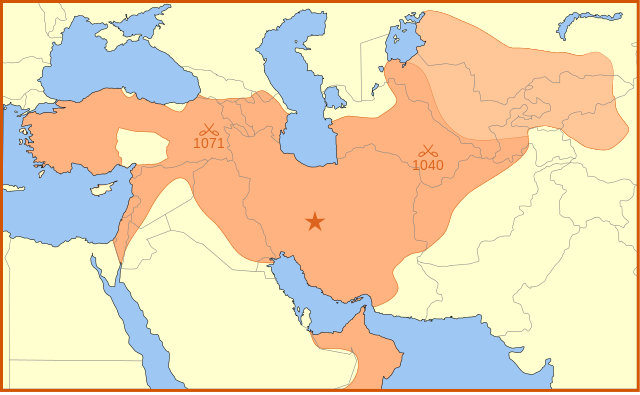 |
This is a file from the Wikimedia Commons. Information from its description page there is shown below.
Commons is a freely licensed media file repository. You can help.
|
 ✓ The source code of this SVG is valid.
✓ The source code of this SVG is valid.
Summary
| DescriptionSeljuk Empire locator map.svg |
English: A map showing the Great Seljuk Empire at its height, upon the death of Malik Shah I in 1092. The capital of the empire is shown at Isfahan. The borders of present-day countries are shown in gray. The lighter colour in the top right represents Karakhanids:
-
- "In 1089, Malik Shah returned to the charge, occupied Bukhara, captured Sarakand, and imprisoned the Karakhanid Ahmed . . . whom he later reinstated as client-ruler. From that time forward, the Karakhanids who reigned in Bukhara and Samarkand did so as lieutenants of the Seljuk sultans. Transoxiana was now no more than a dependency of the Seljuk Empire.", Grousset p. 147.
Other areas such as the Danishmends are not shown separately. The locations of the Battle of Manzikert (1071) and the Battle of Dandanaqan (1040) are also shown.
Nederlands: Het Seltsjoekenrijk op het toppunt van haar macht in nl:1092, ten tijde van de dood van nl:Malik Sjah I. Na diens dood viel het rijk uiteen in verschillende staatjes.
|
| Date |
10 March 2008 |
| Source |
Own work |
| Author |
MapMaster |
References
- Black, Jeremy The Atlas of World History, Covent Garden Books, American Edition, New York, p. p. 228, ISBN 9780756618612
- Grousset, René (1970) The Empire of the Steppes: A History of Central Asia, New Brunswick:Rutgers University Press, 8th paperback edition, 2002, p. 156.
- Hall, Simon and John Haywood (1997) The Complete Atlas of World History: The Medieval & Early Modern World, A.D. 600 - 1783, Armonk, NY: Sharpe Reference.
- Holt, Peter Malcolm; Ann K. S. Lambton; Bernard Lewis (1977) The Cambridge history of Islam, Volume 1, p, 260, ISBN 978-0521291354.
- Hourani, Albert (1991) A History of the Arab Peoples, Cambridge, Massachusetts: The Belknap Press of Harvard University Press, p. 467.
- Shepherd, William (1911) " Europe and the Mediterranean Lands about 1097", Historical Atlas, New York: Henry Holt and Company.
In general, the map was based on Shepherd and on Hall & Haywood, with modifications based on Grousset and Hourani (Hourani's map excludes the area retaken by Byzantium and the Crusaders in 1097-1100). Other maps show the Empire extending into present day Pakistan &/or that include Mecca, but I have found little evidence to support this.
Licensing
I, the copyright holder of this work, hereby publish it under the following licenses:
 |
Permission is granted to copy, distribute and/or modify this document under the terms of the GNU Free Documentation License, Version 1.2 or any later version published by the Free Software Foundation; with no Invariant Sections, no Front-Cover Texts, and no Back-Cover Texts. A copy of the license is included in the section entitled GNU Free Documentation License. http://www.gnu.org/copyleft/fdl.htmlGFDLGNU Free Documentation Licensetruetrue
|
You may select the license of your choice.
|
File usage
The following pages on Schools Wikipedia link to this image (list may be incomplete):
This file contains additional information, probably added from the digital camera or scanner used to create or digitize it. If the file has been modified from its original state, some details may not fully reflect the modified file.
Through Schools Wikipedia, SOS Children has brought learning to children around the world. More than 2 million people benefit from the global charity work of SOS Childrens Villages, and our work in 133 countries around the world is vital to ensuring a better future for vulnerable children. There are many ways to help with SOS Childrens Villages.



